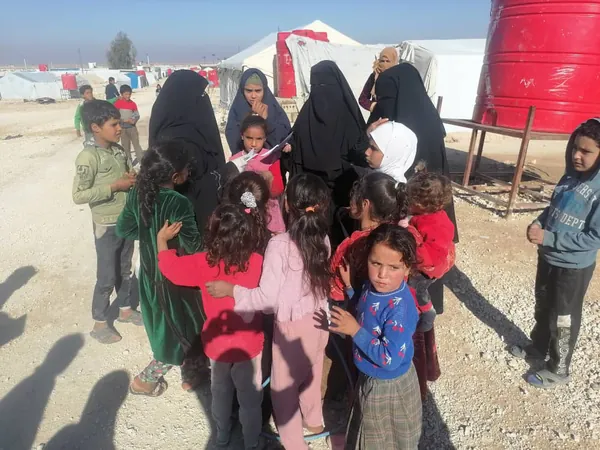
Cholera Vaccination Drive in Al-Hol Camp: A Swift Response to a Growing Crisis
2025-01-19
Author: Mei
In a remarkable display of public health initiative, the Al-Hol camp in northeast Syria—home to nearly 40,000 displaced individuals, primarily women and children—successfully completed a cholera vaccination campaign that addressed a looming health crisis. The camp has long grappled with overcrowding, inadequate shelter, and deplorable sanitation, making it a breeding ground for disease outbreaks. By late 2024, cholera was the latest threat, with over 200 suspected cases reported by December.
The outbreak was exacerbated by contaminated water supplies and insufficient sanitation infrastructure, pushing an already vulnerable population further into peril. In response to this emergency, the World Health Organization (WHO), along with UNICEF, Gavi, the Vaccine Alliance, and local health authorities, orchestrated an ambitious 10-day oral cholera vaccination campaign aimed at immunizing as many residents as possible.
Combating Misinformation
In addition to the public health challenge, misinformation began to spread among the camp's residents. Many questioned the vaccine's safety and its necessity. Local resident Walaa Mohammed took it upon herself to combat these fears. "People were afraid, but I wanted them to understand the vaccine was their best chance to stay healthy," Walaa stated, as she joined the outreach team to educate fellow residents. She engaged directly with individuals in their tents, patiently addressing concerns and countering myths. Her outreach efforts struck a chord, particularly among women, who started to encourage their families to get vaccinated.
Building Trust Among Residents
One pivotal moment occurred in Sector 4 of the camp when Walaa met Ziad, a 30-year-old father who expressed skepticism about the vaccine, believing that cholera primarily affected children. However, after thorough explanations on how cholera spreads and jeopardizes everyone, Ziad’s perspective shifted significantly. Inspired by the campaign's urgency and the collective effort, he eventually joined the outreach initiative.
"I saw how quickly the team acted to help us," Ziad said. "Now, I want to be part of that change."
Reaching Every Corner of Al-Hol
From December 28, 2024, to January 7, 2025, a staggering 25,000 individuals in Al-Hol camp were vaccinated against cholera. This massive undertaking was supported by a well-coordinated team of 40 trained vaccinators, 15 logistical personnel, and 11 vehicles maneuvering through difficult terrain and security constraints to maximize coverage.
Fifty health committee members played a vital role in community outreach, directly informing residents about the vaccine through tent-to-tent visits and group discussions that reached over 16,000 people. For those unable to receive vaccines directly, thousands were directed to designated vaccination points.
The transportation of vaccines adhered to strict cold-chain protocols to maintain their efficacy, prioritizing high-risk areas in sectors 1, 2, and 5—where the outbreak had been most severe. Children aged 5 to 15 represented the majority of those vaccinated, constituting nearly half of all doses administered.
Timely Execution of the Campaign
Executing this vaccination campaign was a race against time, with doses transported from existing stocks in northwest Syria, highlighting the superb coordination among WHO, UNICEF, and local authorities. Every single vaccine dose was utilized effectively, reaching a remarkable 100% vaccination rate.
Apart from curbing the cholera outbreak, this campaign embodied a significant achievement in empowering local communities to take charge of their health.
Walaa proudly reflected on the successful efforts, stating, "We showed that even in the hardest conditions, we can protect each other." As the situation in Al-Hol camp stabilizes, the collaborative approach and community involvement may serve as a model for addressing future health crises in challenging environments.
As the world watches, the resilience and proactive efforts of the residents and health workers offer a glimmer of hope amid ongoing adversity.

 Brasil (PT)
Brasil (PT)
 Canada (EN)
Canada (EN)
 Chile (ES)
Chile (ES)
 Česko (CS)
Česko (CS)
 대한민국 (KO)
대한민국 (KO)
 España (ES)
España (ES)
 France (FR)
France (FR)
 Hong Kong (EN)
Hong Kong (EN)
 Italia (IT)
Italia (IT)
 日本 (JA)
日本 (JA)
 Magyarország (HU)
Magyarország (HU)
 Norge (NO)
Norge (NO)
 Polska (PL)
Polska (PL)
 Schweiz (DE)
Schweiz (DE)
 Singapore (EN)
Singapore (EN)
 Sverige (SV)
Sverige (SV)
 Suomi (FI)
Suomi (FI)
 Türkiye (TR)
Türkiye (TR)
 الإمارات العربية المتحدة (AR)
الإمارات العربية المتحدة (AR)